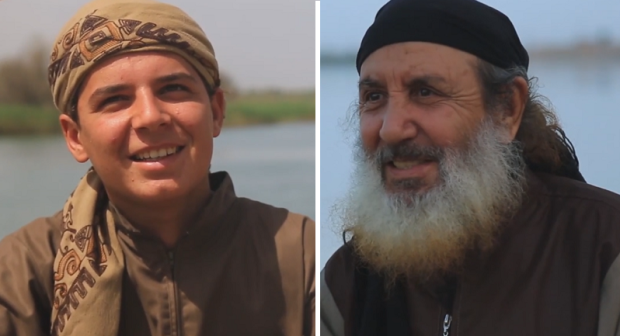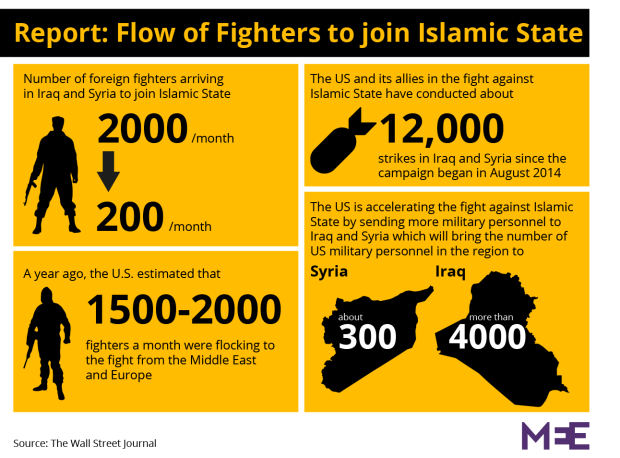IS foreign recruitment has fallen 90 percent, says US general

Islamic State (IS) recruitment of foreign fighters has fallen by 90 percent in the last year, a top US air force commander fighting the group in Syria and Iraq has said.
Peter Gersten, the deputy commander for operations and intelligence for the US-led campaign, says there are now only 200 foreign fighters coming to Iraq and Syria to join IS a month, compared to between 1,500 and 2,000 this time last year.
The commander did not mention Libya, where the IS threat has been growing in recent months.
“We’re seeing an increase in the desertion rates of [Islamic State] fighters,” Gersten said. “We’re seeing a fracture in their morale.”
He said there have been increasing reports of desertions with fighters going as far as to dress up as women to escape IS-held territory, saying that this was a sign that US-led bombing campaigns against the militants had grown more effective.
Russian and Syrian government planes also bombarded IS-held territory in Syria, recently driving them from Palmyra, while the Iraqi army and the Kurdish Iraqi Peshmerga have, with US help, begun an assault on Mosul, the militants' de facto capital in Iraq that fell in 2014.
American intelligence in February revised its estimates to say that the number of IS fighters in Iraq and Syria had declined from 31,000 to about 25,000.
Some analysts have suggested that the shift could also signify a change in tactics, with the militants increasingly calling on its supporters to stay in their home countries and carry out attacks there, akin to the attacks in Paris late last year and in Brussels last month. However, Kyle Orton, an analyst and research fellow at the Henry Jackson society, told Middle East Eye that it was "not as simple as IS losing in their heartlands and so attacking outside".
"Attacks outside have always been an integral part of what IS is and what IS does,” Orton said. “The external attacks are meant as propaganda to draw in more recruits by showing how powerful IS is and also as a deterrent as they are meant to stop other countries from being involved in attacks against them.”
Turkish route disrupted
Sam Heller, a Beirut-based writer and analyst, also told MEE that "weakening foreign fighter recruitment was largely due to the disruption of Turkish border routes and the diversion of foreign fighters to other IS battlefields" like Libya.
The announcement comes days after a IS recruitment video, heavily featuring elderly and adolescent fighters, appeared on the militant group’s social media networks and websites.
In the video, background music sings that joining the “jihad is the best thing for you” while elderly men talk about how joining IS has helped them feel young again.
The video also tells its fighters that victory does not come through "recovery of Palmyra or Shaddadi," two Syrian towns IS has recently lost, but through persistence on a set path, or "manhaj".
An elderly man is seen addressing Muslims, calling on them to join: “How is it that I, at this age, have come and you, who are young and healthy, are still abstaining from jihad?”
“I ask Almighty God to end my life on this earth.”
A teenage IS member also addresses possible recruits, saying that he joined the group when he was just 14 and then served as a guard in “Deir Ezzor military airport, until God gave me the honour of taking part in a suicide mission”.
Orton described the video as another "data point" indicating that IS was losing ground. "They have used child soldiers before, but the appearance of the elderly is something quite new."
However, Heller says that the tone is a mixed one and that the video should not necessarily be seen as a sign of growing desperation.
"This video [is not] hugely different or significant. The old/young trope is something I've seen elsewhere and in other factions," he said.
"It's a recruiting ploy, but I don't think it's necessarily a sign of weakness."
The comments on Palmyra though were "genuinely defensive, like they're trying to reassure their fans after successive losses and also temper expectations that they'll quickly recover this territory".
IS swept through swathes of Syria and Iraq in the summer of 2014.
While a US-led anti-IS coalition was mobilised against the militants later that year, and some 12,000 bombs have since dropped on IS targets, IS continues to control territory a significant chunk of territory in eastern Syria and western Iraq.
New MEE newsletter: Jerusalem Dispatch
Sign up to get the latest insights and analysis on Israel-Palestine, alongside Turkey Unpacked and other MEE newsletters
Middle East Eye delivers independent and unrivalled coverage and analysis of the Middle East, North Africa and beyond. To learn more about republishing this content and the associated fees, please fill out this form. More about MEE can be found here.






